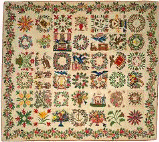Textile Society of America

Textile Society of America: Symposium Proceedings
Date of this Version
2016
Document Type
Article
Citation
Crosscurrents: Land, Labor, and the Port. Textile Society of America's 15th Biennial Symposium. Savannah. GA. October 19-23. 2016.
Abstract
Tablet weaving is one of the oldest techniques of expressing patterns, including script, with a warp thread. It is practiced in an extremely limited area and was considered a rare weaving technology. However, in the past it was developed to a level of highly skilled production among the people of Burma (now Myanmar). The scripts reveal the patronage of specific Buddhist believers and sometimes the provenance of the textile. The script on the belt that secures the covering on the sacred book of the palm leaf manuscript of Myanmar includes dates that establish that this type of weaving was practiced from 1892 through 1928. The belt uses a tablet weaving type called “Sar Htoke Kyo.” It was reported that this weaving technology became extinct, but fortunately, the technique has been preserved by Saunders Weaving Institute near Mandalay. In this paper, I discuss tablet weaving techniques handed down among the Burmese people and investigate their culture, historical significance, and new movements. (All photos are taken by Tomoko Torimaru, and all illustrations are created by Tomoko Torimaru.)
Included in
Art and Materials Conservation Commons, Art Practice Commons, Fashion Design Commons, Fiber, Textile, and Weaving Arts Commons, Fine Arts Commons, Museum Studies Commons


Comments
Copyright 2016 by Tomoko Torimaru.